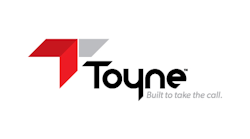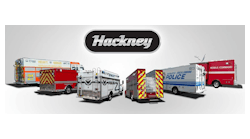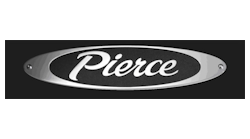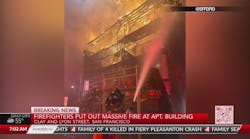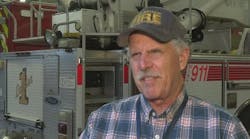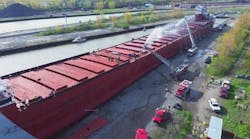It is no secret the economy is in deeply troubled times. Fire stations are closing. Firefighters are losing their jobs and taxpayers are having trouble paying their taxes. Yet, your department needs a replacement engine and the aerial is getting a little shaky too. You say there is no money and you have been turned down a few times for federal FIRE Act grants, but there is hope that you can afford that new apparatus you actually needed yesterday.
Some apparatus manufacturers offer exclusive financing deals, others have program apparatus designed to save money and all say it is best for fire departments to take a serious look at what they truly need and what they would like to have. Deleting the “bells and whistles” without sacrificing safety and quality is one of the best ways to save money. Another way is to look carefully at how to pay for the apparatus. Lease-purchase agreements, tax-exempt financing and even looking at lesser-known federal grants are all ways to find dollars to make that crucial purchase.
American LaFrance
Richard Ball, director of marketing for American LaFrance, is convinced there are ways departments can get the apparatus they want and need even though the economy is in the dumps.
“You can afford the custom truck you want,” said Ball. “You don’t have to settle for a commercial truck. We have programs to help.”
Ball said American LaFrance had a program truck that was built on a commercial cab and chassis, called the Liberty Series, and the company found its custom-cab apparatus was still favored and more popular. So, the company found ways to make that apparatus more affordable. This month, American LaFrance will start a new lease program backed by its partner Sovereign Bank. The program has five- and eight-year terms. Ball said leases often make it easier for departments to get into new apparatus with no need for bonding and predictable payments.
The company has also developed a Parts Credit Program where departments can choose options that will allow them to purchase parts or accessories for the new apparatus, or for use on their existing fleet up to 6% of the apparatus purchase price, based on advance payment for the new unit. American LaFrance also offers a guaranteed trade-in price, based on the value of the apparatus purchased. After an eight- to 10-year lease is concluded, the company will buy back the truck for 20% of the original price. Ball said that option allows departments to have some predictability when it comes to future purchases. “We are all about creating real value for the customer,” Ball said. “Lowering the price is not a good idea for the customer or for us. We would rather provide tangible value.”
Crimson
Bill Doebler, vice president of sales and marketing for Crimson Fire, said today’s apparatus market is off by as many as 1,700 units annually compared to the best years.
“It’s been like that for three or four years,” Doebler said. “For the first time, ever, it looks like the global apparatus market is going to exceed sales in the U.S.”
For the purchaser, that means makers are willing to deal and one way is deferred payments for up to a year, he said. That gives departments up to three years to come up with the first payment from the time of specifications. There is, however, an interest cost for that, but some departments are willing to accept that cost so they can be better prepared to make the payment with more coin drops, pancake breakfasts and other fundraising activities.
Doebler has also seen sponsorships as a creative way to pay for apparatus. Some departments will solicit businesses and then put a logo or other notation on apparatus or at the fire station acknowledging the contribution. “Departments are coming up with very unique ways of financing apparatus,” he said.
To save money, Doebler said, he has noticed departments willing to accept stock and demo units that sometimes cost less, but are always more readily available than unique, “blank sheet-design” apparatus built to department specifications. “They come to us and say they’ve got the money, or the approval to buy apparatus and they’ll ask us what we have now,” Doebler said. To meet that demand, Crimson is building apparatus to specification and a backlog that, with minor alterations and options, can get apparatus to the customers very quickly.
Darley
Peter Darley, the vice president and chief operating officer of the family owned W.S Darley & Co., said the apparatus market is about half of what it used to be because of the economic slowdown, and it will likely be slow for a period into the future. Nevertheless, he said, departments are going to need apparatus and, perhaps they ought to look at smaller vehicles that are less expensive, but will still do the job. “Something is better than nothing,” he said.
Darley said the start of getting any apparatus in the station starts with convincing municipal officers about the need and “doing a good job” convincing those who will approve the purchase of need.
“It’s important to do your homework,” Darley said, adding that time spent on convincing local officials about the need for apparatus is better spent than writing grants for ever-shrinking federal money.
“Part of the process is doing due diligence,” Darley said. He added that convincing municipalities that it cost just as much, or more, to keep old trucks in good repair and safe makes it easier to buy new apparatus. He said he is also convinced that now is the best time to buy apparatus because lending institutions and apparatus makers are “hungry” for business and may be willing to offer very attractive loan and lease rates and makers will offer better prices.
One way to get the best price is to seek a request for proposal or negotiate with an apparatus maker rather than going out to bid, Darley said. As long as the apparatus is National Fire Protection Association (NFPA) compliant, negotiating a price often results in lower prices, he said.
E-ONE
Larry Daniels and Chris Wade are both regional sales directors for E-ONE with close to 50 years in the fire apparatus business combined. Both recognize the challenges departments face and both feel there are ways to get new apparatus in the station.
Daniels said the best way to specify an affordable apparatus is to start with a blank piece of paper and write down everything a new unit should have, then narrow the list to the top five “must-haves.” He noted it is likely the list will have a 1,500-gpm pump and a 1,000-gallon water tank. From there, the list can grow quickly and more costly, he said.
“The days of the $600,000 custom pumper are behind us,” Daniels said.
Daniels said E-ONE offers a Traditions Series program line of apparatus that is built on the same manufacturing line as the company’s highly customized apparatus so there is no difference in quality.
Savings, Wade said, come from a limited number of options and efficiencies of volume, not from skimping on quality. Another way departments can save money is to consider stock units, apparatus the company builds for demonstration or for immediate delivery. Some of those units are priced at around $250,000 for a basic pumper and can be delivered in two to four months, including aerial units, Wade said. And, when the company has a backlog of demonstrators, it is possible for departments to still have some limited options and “tweaks” before taking delivery.
And when it comes to doing more with less, Daniels said, departments should consider multi-function apparatus. He said E-ONE has a new line of apparatus, called E-MAX, which combines rescue and pumper functions into one unit with obvious savings.
There are ways to finance apparatus and come up with creative purchasing solutions too, Wade said, noting that E-ONE offers lease-purchase programs from three to 15 years. When considering payments, Wade said it is important to note when interest and payments are due. It is not a good deal when the payments come due before the apparatus is delivered, Wade said noting that it can take up to 16 months for some aerials to be built and if interest starts from the time of the contract signing, it can be unnecessarily costly for the departments.
Daniels said departments should be creative about ways to raise funds too. Colleges and hospitals sometimes will help departments pay for apparatus that will be used to help protect their properties. And Wade said it pays to look for grants in unusual places, like federal Community Development Block Grants, offered through the U.S. Department of Housing and Urban Development (HUD), which he said offers money to targeted communities for fire apparatus to help protect growing communities.
Wade also believes that the conservative approach to purchasing apparatus will someday give way as old apparatus wears out and communities are forced to start buying new trucks. “The bubble has to break sooner or later,” Wade said.
Hackney
Ed Smith, director of sales and marketing for Hackney Emergency Vehicles said he has noticed many departments are buying less apparatus than they are accustomed to, spending only $100,000 on a rescue vehicle when they previously would spend up to $300,000 for apparatus to do the same job.
Some departments are buying smaller units, based on Ford F-550 cabs and chassis and using utility bodies instead of custom apparatus, he said.
“You should really look at what the apparatus needs to do and question what needs to be on it,” Smith said. “…You should look at things that don’t really provide any more safety or fight fires more effectively. Look for something that still gets the job done.”
While Hackney will never compromise quality and safety, he said, the company is looking at manufacturing processes that save money. For instance, Hackney recently started looking at the material it uses in smaller compartment trays and slightly reduced the thickness, which saves about $1,100 per unit without any sacrifice to strength or quality.
Custom apparatus can have hundreds of hours of engineering time built into each unit, Smith said. Departments buying apparatus that have been pre-engineered can have money because the final unit will not need all those engineering costs built in. “I think we’re going to see another three to four years of tight budgets,” Smith said.
H&W
Steve Jahn, the president and chief operating officer of H&W Emergency Vehicle Group, believes one of the best ways to save money on apparatus purchases is to do it through a negotiated sale. Using request for proposals (RFPs) and then talking with the prospective manufacturers can often lead to a better price.
Departments must check local laws to make sure negotiated sales are permitted, Jahn said. Many departments require committees and then bidding which have pluses and minuses, he said. “As a general rule of thumb, the larger the committee, the larger the price,” Jahn said.
And speaking of larger, larger is also not always better when one is considering drive-train components like engines and transmissions. Jahn recommends departments look at the call types as well as the geography of the response area.
Departments often do not need the kind of “firepower” they think they need when it comes to horsepower, he said, and often end up spending much more than necessary. Smaller engines, with the proper gearing, will hardly affect performance at all, he said, and the cost savings can be $20,000 or more.
Jahn said the apparatus market is off by about 35% and that has some positive effects for consumers.
“It drives apparatus manufacturers and distributors to be more creative in offering competitive options, features and packaging (and financing) to make apparatus affordable and spur sales,” he said.
KME
Phil Gerace, KME Fire Apparatus’ director of sales and marketing, says there is a real Catch-22 going on with apparatus when it comes to cost compared to budgets. Emission requirements are driving the cost of apparatus up as much as 10%, NFPA requirements are driving costs up and the general inflation drives costs up too. However, departments have less and less funding to purchase apparatus. There will come a time, however, when departments must purchase new apparatus and Gerace said customers must look at the total cost of ownership when they make their decisions.
Factors in the final costs include not only the initial price, but the cost of financing and perhaps most important of all is the cost of maintenance, Gerace said. Departments need to look at the manufacturers’ abilities to support the apparatus over its life.
“You’re not buying apparatus for just year one,” Gerace said. “You have to consider the total life of the product.”
Gerace said departments that look to grants for funding must be especially thoughtful when writing them. Too many times, grants sought by worthy departments are kicked out because they are poorly written and not well-thought-out. “Poor presentations by rushed individuals can jeopardize the departments’ chances,” Gerace said.
Marion
Shane Krueger, sales manager of the rescue, fire division of Marion Body Works, is a big proponent of pre-sold demonstrator units for saving money. Companies, including Marion, are all going to build demonstrator units for shows and sales presentations. If a department can negotiate with the company, Marion will build what the department wants with the understanding that it will be driven a certain number of miles and be on the road for a certain period.
“We give a pretty good discounting on that kind of apparatus,” Krueger said. To save money, Krueger said, Marion will reuse and remount certain equipment on new apparatus – cord and hose reels, for example – if they are in good shape and arrangements are made at the time the apparatus is specified. “That can save departments a lot of money,” he said.
Another way to save money at the time of specification is to build into the apparatus accommodations for future accessories and equipment, he said. “It becomes almost plug-and-play when the department can afford to buy it in the future,” Krueger said, noting it is far less expensive to build for the future than it is to try to reconstruct after the apparatus is completed.
There are some items, such as lettering and graphics, that departments may find more affordable if done locally, especially if the shop is willing to make a donation or a cost reduction for the ability to claim the local apparatus as an example of its work.
Pierce
Tom Whitmer, director of business development for Oshkosh Capital, a division of the Oshkosh Corp., parent company of Pierce Manufacturing, touts a proprietary lease program for Pierce apparatus as a good way of getting departments the apparatus they need. Pierce Flex Financing, which is exclusive for Pierce apparatus, offers serious savings for departments, Whitmer said. The Pierce financing program has a tax-exempt lease for municipalities where Pierce gets tax credits for leasing money to towns and cities and passes the savings on to the departments in reduced interest rates, Whitmer said, adding that the payments are tied to a department’s budget cycle and do not start until the next cycle.
“Interest rates are at historically low levels,” Whitmer said. “We believe it’s an opportune time to purchase equipment.”
Pierce, through Oshkosh Capital, offers 15-year, 100% finance programs at a fixed rate for the entire term with no closing costs, Whitmer said. Another advantage of leasing is not having to go to the voters for bond approval to get the equipment they need. “We think it’s a good solution for our customers,” he said.
Toyne
Mike Watts, national sales manager for Toyne Inc., said when departments are looking for affordable apparatus, they should not be willing to sacrifice quality. To meet the needs of price-conscious departments, Toyne developed a program truck called the HQRP (for high-quality, reasonably priced), Watts said. Customers pick one of five body styles that have been pre-engineered and offer the accompanying cost savings.
“Not all trucks are created equal,” Watts said, adding that a higher-quality truck is going to last longer and give better service than a lower-quality unit.
“An apparatus will be around for 20 to 25 years,” Watts said. “So you have to look at total cost of ownership, not simply who is the lowest price at the bid table.”
